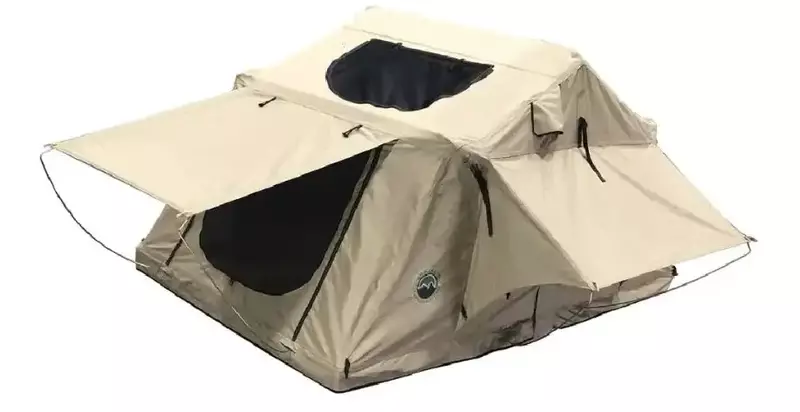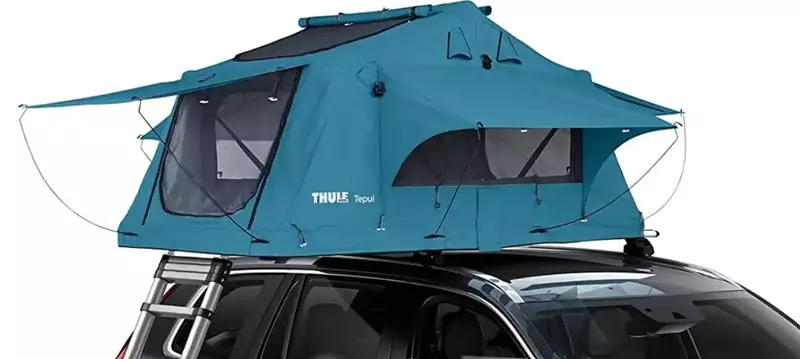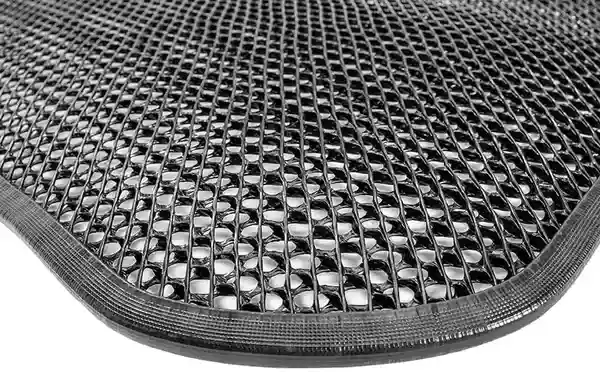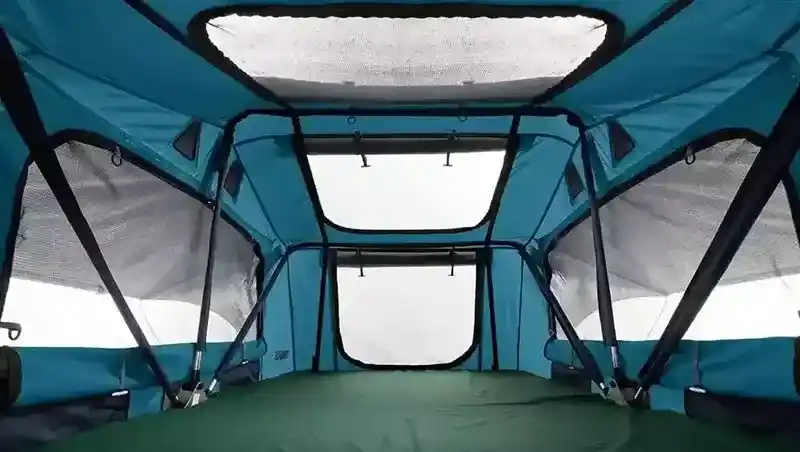Regarding condensation there is no much difference between roof top tents and ordinary ground tents, you face the same problems, and the same principles apply.
The short answer to the question in the title is no, you cannot avoid condensation in a roof top tent. This is natural, and the effect depends on many factors. These include:
- The temperature difference inside and outside.
- The material and construction of the tent.
- Presence or absence of mesh openings and vents.
- The number of occupants.
Knowing all this may help in reducing condensation and learning how to deal with it when it happens.
Temperature difference
Ordinary tents are not so great insulators, but the temperature difference inside vs outside can indeed be anywhere in the range 1-15 degrees Celsius. This depends on how the tent is built, and the issue was discussed in detail in my text about standard winter tents.
So the warmer air inside will tend to create moisture on the walls of such a tent that is built from a very thin material. This all depends on several other factors discussed below.
The air always contains some percentage of water vapor and this vapor will condense onto the tent wall if:
- The wall surface is at the temperature below the dew point temperature.
- The water vapor equilibrium in air has been is exceeded.
You can find more about this physical effect on Wikipedia. This condensation can be so bad that sometimes people wrongly think that the tent is not waterproof.
The effects of the material and construction of the tent
Breathable fabric
You will normally have far less condensation in a breathable cotton canvas or polycotton tent than in a synthetic tent. This is because vapor can naturally escape through the pores in the fabric. Vapor in air is typically of the size 10-15 microns.
Normally, such polycotton tents you have at Crua Outdoors, they have their Crua AER series with such materials. But in specifications they write that it is with a PU coating so I am not sure if they can be described as fully breathable.
The TMBK 3 Person Roof Top Tent by Overland Vehicle Systems (the picture below) is with such a poly cotton ripstop fabric. Note that it is available also at the Overland Junction.

Multi-layer construction
Some synthetic tents can be true double-layer structures with an inner taffeta tent, and these should produce less condensation than any other synthetic tent. This is because the inner layer will be less cold and it will produce less condensation.
Do you know that there are some excellent roof top tents that are built in three layers? One great example is the Freespirit Evolution rooftop tent. Its body is what they call the tri-layer technology with a polycotton fabric between two synthetic layers.
With such a construction and with some extras that you have there, condensation is indeed reduced a lot.
The same construction with three layers you can find in their Freespirit Recreation High Country 80 roof top tent (the picture below). But here you have a soft shell type shelter.

Mesh openings and vents help in reducing condensation
You will always read about necessity for increasing ventilation to reduce condensation. This advice has its meaning, but it useless when it rains and you also have winds.
In such situations you cannot keep tent’s windows with mesh, you have to close everything. Sometimes you have awnings that protect windows so you can keep them with mesh.
This can work in many situations and you will have a good ventilation as long as it is not really windy when you are forced to put the awning down. One great example you can see in the picture below.
So do not be fooled with claims about great ventilation because of 360 degrees views and great mesh windows. All hard top pop-up roof top tents have this. But not all of them are really ventilated tents.
The reality is that in some situations you have to rely on vents. The Freespirit Evolution roof top shelter mentioned above is with vents, you have them on the walls and also on the roof. This is a rare feature in hard top pop-up tents.
Yet another great example with vents is the Thule Tepui Explorer Ayer 2 Rooftop Tent shown in the picture. As you see, it has very functional awnings above windows, but it also has 4 vents on the side walls, two are visible in the picture.

The previously shown TMBK 3 Person Roof Top Tent is also with vents, if you go back you will see one on the side.
But see the vents also in this beautiful soft shell type TentBox Lite roof top tent, this is a short video:
What to do with the condensation on the floor of a roof top tent?
Roof top tents almost always have a solid bottom. So condensation can accumulate on the floor of such a roof top tent and the mattress can become wet. This all can result in the growth of mold and mildew, so it is important to avoid this.
There are anti-condensation mats for this purpose you can see the Thule Tepui Anti-Condensation Mat for Rooftop Tents in the picture. Crua Outdoors also has something similar.

But you can also go for a bottomless roof top tent, there are such options on the market. The Freespirit Evolution rooftop tent is such an example.
Are soft shell roof top tents better than hard shell roof top tents regarding ventilation?
I do not think that there can be a simple answer to this. Hard shell roof top tents include two very different basic designs:
- Clamshell hard shell roof top tents.
- Pop-up hard-top hard shell roof top tents.
The first group has more fabric on on the walls and canopy, and they may have more options for ventilation when it rains and you have to keep windows and doors with closed panels. Such tents can also have skylight windows.
On the other hand, the second group always has a hard-top type roof where normally you cannot expect openings for vents. These pop-up tents are currently mostly without vents. But you have seen above that there are some good models that do have side vents as well as roof vents.
Soft shell roof top tents have more fabric because the roof is also fabric. In the case of breathable materials (some examples are mentioned in the previous text) this allows for more area for vapor to escape.
Many soft shell roof top tents indeed have vents, but this is currently a far less frequent feature in hard top tents. Soft shell roof top tents may have more windows with awnings as well.
All in all, there are probably more examples of soft shell roof top tents with a good ventilation in any weather conditions, than what you might find in the group of hard shell roof top tents.
Conclusion
In summary, condensation in roof top tents cannot be avoided in general, but it can be minimized if you do the right choice. The optimal combination of features in such a shelter would include some of the following:
- A shelter built from a breathable fabric.
- A shelter that has integrated vents.
- Numerous mesh windows and at least one skylight window.
- A bottomless roof top tent.
- A tent with multiple layers.
You might want to read also my another text on how roof top tents behave in windy conditions. Note also that some brands have accessory insulation for their roof top tents so you can use them year round.
Let me know if you have questions, there is a comment box below. Bookmark this site and keep as a reference, you will always have new texts about outdoors added here. Thank you for reading and have a nice day.

 Hi, I am Jovo, the founder of this Off-Ground Tents site and several other outdoor sites. I have been mountaineering for almost 40 years already, and I have created this site to use as a reference for various types of above ground tents.
Hi, I am Jovo, the founder of this Off-Ground Tents site and several other outdoor sites. I have been mountaineering for almost 40 years already, and I have created this site to use as a reference for various types of above ground tents.